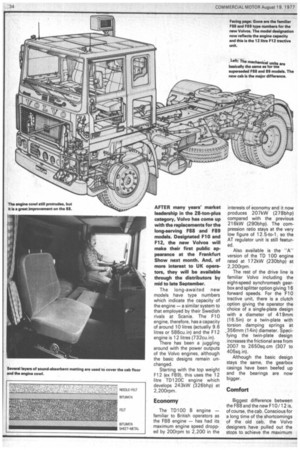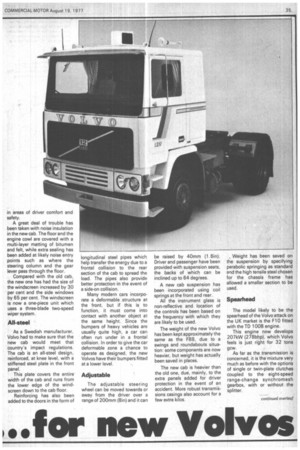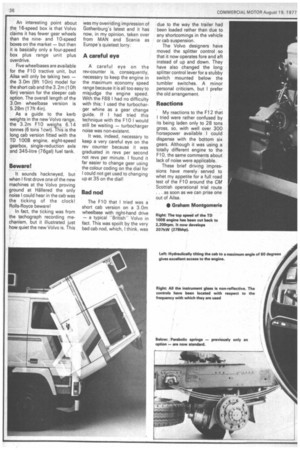AFTER many years' market leadership in the 28-ton-plus category, Volvo
Page 36

Page 37

Page 38

If you've noticed an error in this article please click here to report it so we can fix it.
has come up with the replacements for the long-serving F88 and F89 models. Designated F10 and F12, the new Volvos will make their first public appearance at the Frankfurt Show next month. And, of more interest to UK operators, they will be available through the distributors by mid to late September.
The long-awaited new models have type numbers which indicate the capacity of the engine — a similar system to that employed by their Swedish rivals at Scan ia. The F10 engine, therefore, has a capacity of around 10 litres (actually 9.6 litres or 586cu.in) and the F12 engine is 12 litres (732cu.in).
There has been a juggling around with the power outputs of the Volvo engines, although the basic designs remain unchanged.
Starting with the top weight F12 (ex F89), this uses the 12 litre TD120C engine which develops 243kW (326bhp) at 2,20Orpm.
Economy
The TD100 B engine — familiar to British operators as the F88 engine — has had its maximum engine speed dropped by 200rpm to 2,200 in the interests of economy and it now produces 207kW (278bhp) compared with the previous 216kW (290bhp). The compression ratio stays at the very low figure of 12.5-to-1, so the AT regulator unit is still featured.
Also available is the -A" version of the TD 100 engine rated at 172kW (230bhp) at 2,20Orpm.
The rest of the drive line is familiar Volvo including the eight-speed synchromesh gearbox and splitter option giving 16 forward speeds. For the F10 tractive unit, there is a clutch option giving the operator the choice of a single-plate design with a diameter of 419mm (16.5in) or a twin-plate with torsion damping springs at -356mm (14in) diameter. Specifying the twin-plate design increases the frictional area from 2007 to 2650sq.cm (307 to 405sq. in).
Although the basic design stays the same, the gearbox casings have been beefed up and the bearings are now bigger.
Comfort
Biggest difference between the F88 and the new F10/ 12 is, of course, the cab. Conscious for a long time of the shortcomings of the old cab, the Volvo designers have pulled out the stops to achieve the maximum in areas of driver comfort and safety.
A great deal of trouble has been taken with noise insulation in the new cab. The floor and the engine cowl are covered with a multi-layer matting of bitumen and felt, while extra sealing has been added at likely noise entry points such as where the steering column and the gear lever pass through the floor.
Compared with the old cab, the new one has had the size of the windscreen increased by 30 per cent and the side windows by 65 per cent. The windscreen is now a one-piece unit which uses a three-blade two-speed wiper system.
All-steel
As a Swedish manufacturer, Volvo had to make sure that the new cab would meet that country's impact regulations. The cab is an all-steel design, reinforced, at knee level, with a stiffened steel plate in the front panel.
This plate covers the entire width of the cab and runs from the lower edge of the windscreen down to the cab floor.
Reinforcing has also been added to the doors in the form of longitudinal steel pipes which help transfer the energy due to a frontal collision to the rear section of the cab to spread the load. The pipes also provide better protection in the event of a side-on collision.
Many modern cars incorporate a deformable structure at the front, but if this is to function, it must come into contact with another object at the same height. Since the bumpers of heavy vehicles are usually quite high, a car can often run under in a frontal collision. In order to give the car deformable zone a chance to operate as designed, the new Volvos have their bumpers fitted at a lower level.
Adjustable
The adjustable steering wheel can be moved towards or away from the driver over a range of 200mm (Bin) and it can be raised by 40mm (1.6in). Driver and passenger have been provided with suspension seats, the backs of which can be inclined up to 64 degrees.
A new cab suspension has been incorporated using coil springs at the front and rear.
All the instrument glass is non-reflective and location of the controls has been based on the frequency with which they are likely to be used.
The weight of the new Volvo has been kept approximately the same as the F88, due to a swings and roundabouts situation: some components are now heavier, but weight has actually been saved in places.
The new cab is heavier than the old one, due, mainly, to the extra panels added for driver protection in the event of an accident. More robust transmissions casings also account for a few extra kilos. , Weight has been saved on the suspension by specifying parabolic springing as standard and the high tensile steel chosen for the chassis frame has allowed a smaller section to be used.
Spearhead
The model likely to be the spearhead of the Volvo attack on the UK market is the F10 fitted with the TD 10013 engine.
This engine now develops 207kW (278bhp), which Volvo feels is just right for 32 tons gcw.
As far as the transmission is concerned, it is the mixture very much as before with the options of single or twin-plate clutches coupled to the eight-speed range-change synchromesh gearbox, with or without the splitter. An interesting point about the 16-speed box is that Volvo claims it has fewer gear wheels than the nineand 10-speed boxes on the market — but then it is basically only a four-speed box plus range unit plus overdrive.
Five wheelbases are available for the F10 tractive unit, but Ailsa will only be taking two — the 3.0m (9ft 10in) model for the short cab and the 3.2m (1 Oft 6in) version for the sleeper cab option. The overall length of the 3.0m wheelbase version is 5.28m (17ft 4in).
As a guide to the kerb weights in the new Volvo range, the 3.2m F10 weighs 6.14 tonnes (6 tons lowt). This is the long cab version fitted with the TD 100B engine, eight-speed gearbox, single-reduction axle and 345-litre (76ga1) fuel tank.
Beware!
It sounds hackneyed, but when I first drove one of the new machines at the Volvo proving ground at Hallered the only noise I could hear in the cab was the ticking of the clock! Rolls-Royce beware!
In fact, the ticking was from the tachograph recording mechanism, but it illustrated just how quiet the new Volvo is. This was my overriding impression of Gothenburg's latest and it has now, in my opinion, taken over from MAN and Scania as Europe's quietest lorry.
A careful eye
A careful eye on the rev-counter is, consequently, necessary to keep the engine in the maximum economy speed range because it is all too easy to misjudge the engine speed. With the F88 I had no difficulty with this; I used the turbocharger whine as a gear change guide. If I had tried this technique with the F10 I would still be waiting — turbocharger noise was non-existent.
It was, indeed, necessary to keep a very careful eye on the rev counter because it was graduated in revs per second not revs per minute. I found it far easier to change gear using the colour coding on the dial for I could not get used to changing up at 35 on the dial!
Bad nod The F10 that I tried was a short cab version on a 3.0m wheelbase with right-hand drive — a typical -BritishVolvo in fact. This was spoilt by the very bad cab nod, which, I think, was
due to the way the trailer had been loaded rather than due to any shortcomings in the vehicle or cab suspension.
The Volvo designers have moved the splitter control so that it now operates fore and aft instead of up and down. They have also changed the long splitter control lever for a stubby switch mounted below the tumbler switches. A minor personal criticism, but I prefer the old arrangement.
Reactions
My reactions to the F12 that I tried were rather confused by its being laden only to 28 tons gross, so, with well over 300 horsepower available I could dispense with the bottom six gears. Although it was using a totally different engine to the F10, the same comments about lack of noise were applicable.
These brief driving impressions have merely served to whet my appetite for a full road test of the F 1 0 around the CM Scottish operational trial route
. as soon as we can prise one out of Ailsa.
• Graham Montgomerie




































































































